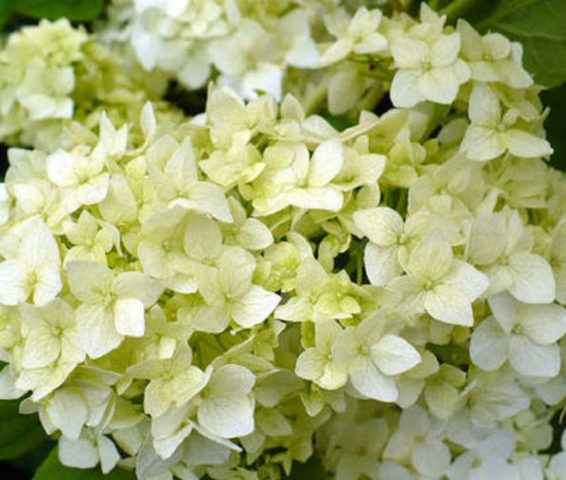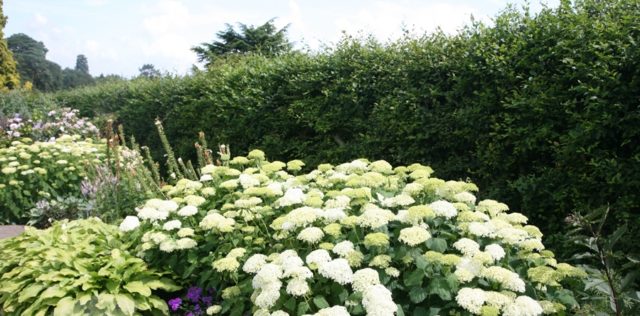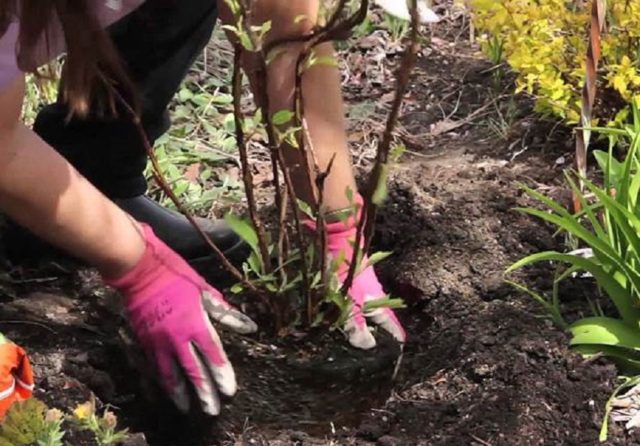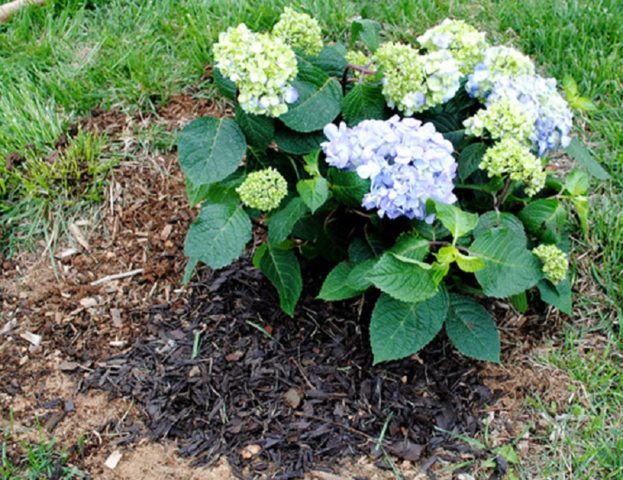Content
Hydrangea Sterilis belongs to the tree-like variety of the showy plant. The Latin name is Hydrangea arborescens Sterilis. A tree-like hydrangea native to North America, more precisely, the eastern part of the continent. The decorativeness of the shrub attracts the attention of many gardeners. It takes a little knowledge and skill to grow such beauty.

Sterilis bush looks amazing in any composition
Description of hydrangea Sterilis
Sterilis is a fast growing variety that forms beautiful hemispherical inflorescences. External characteristics:
- The height of the bush is 120-150 cm, diameter is 150 cm, the shape is round. The bush is upright.
- Sterilis shoots are thin, slightly pubescent, spreading. They do not differ in elasticity, therefore they can bend from the severity of the inflorescences.
- Sterilis leaves are ovoid, their length reaches 20 cm, the color is bright green. The bottom plate has a bluish tint. The petioles are thin and long, the leaves are located opposite each other on the shoots.
- The inflorescences are rather large. Diameter from 15 cm to 20 cm, flowers are small, their diameter is only 1 cm.The color is greenish-white, then becomes pure white. A feature of the Sterilis variety is considered to be abundant and long flowering, which lasts from early July to late September. The flowers are sterile.

On close inspection, the flowers look very harmonious.
Some gardeners confuse the Sterilis tree hydrangea with the large-flowered hydrangea. However, these species have a clear distinction. Sterilis forms flatter flowers. Visual information:
https://www.youtube.com/watch?v=04j9q5xH9TM
Hydrangea tree Sterilis in landscape design
When composing compositions, Sterilis Hydrangea is recommended to be used in group or single plantings. It looks very good on the lawn or in complex combinations with conifers. In combination with evergreen and deciduous shrubs, it can decorate any part of the garden. It perfectly plays the role of a tapeworm in the preparation of woody and shrub compositions. The decorativeness of the Sterilis hydrangea is used by landscape designers in any projects, and it grows well on acidic soil and in low light.

White "caps" of inflorescences are easy to fit into any panorama
Winter hardiness of hydrangea Sterilis
Gardeners know that most of the hydrangeas are grown in the south. The heat-loving nature of this plant does not allow it to survive at very low temperatures. The sterilis tree variety is able to withstand the cold for 2 months.
You can help the Sterilis hydrangea regain vitality by timely feeding and competent pruning. The main thing is that the bush is protected from dry winds.
Planting and caring for hydrangea tree sterilis
The variety can be planted in spring and autumn in the southern part of Russia. For the middle lane and northern regions, spring is preferable. Planting Sterilis has its own subtleties, the knowledge of which allows you to grow a shrub without problems. After all, the moment of planting is a very important stage in the life of a plant, influencing its further growth and development. The main nuance is the composition of the soil. Hydrangea prefers acidified soil.
Selection and preparation of the landing site
The decorativeness of the shrub directly depends on how the place for planting the treelike hydrangea Sterilis is correctly selected. In this case, it is imperative to take into account the region in which the plant is planted. For areas of warm climates, you need to choose partial shade. The sun does not prevent the Sterilis hydrangea from blooming luxuriantly, but the bush will have to be watered regularly and abundantly. On the territory of the middle lane, it is better to choose a site with good lighting. An "openwork shadow" will do. Sterilis young seedlings need protection from the midday sun and winds.
The second important parameter is soil. Hydrangea grows poorly in poor and dry soil. A mixture of humus, peat, leafy earth, sand in a ratio of 2: 1: 2: 1 is best suited for Sterilis.
The shrub prefers slightly acidic soil (pH not less than 5.0). Demanding for moisture is even embedded in the name of the plant: "hydrangea" is translated from Latin as "a vessel with water".
Landing rules
The size of the planting pit varies depending on the volume of the root system or the soil clod of the container seedling. Most often, for a hydrangea, it is enough to dig a cube with sides of 30-40 cm.

The root system should fit easily into the planting hole
If you plant several Sterilis plants, then the distance between them must be maintained at least 1 m. Further actions:
- Pour in a nutrient mixture made from humus, compost, peat, sand and leafy earth. The ratio is indicated above.
- Check the roots, cut off the broken, very dry, very long ones. The main body must be the same length. Untangle the roots of container plants Sterilis and cut them a little.
- Soak roots in heteroauxin solution. Time ranges from 2 to 24 hours.
- Place the root collar of the shrub at the level of the ground surface and try not to cover it with earth.
- Slightly compact the soil, water the seedling abundantly.
In the early days, the hydrangea must be protected from direct sunlight and strong air flow.
Watering and feeding
Hydrangea Sterilis needs regular watering. Irrigation frequency - once every 7 days. One bush requires up to 20 liters of water. If the weather is with regular precipitation, then the frequency is reduced to 1 time per month. After watering, the soil around the Sterilis trunk should be mulched with peat, sawdust or wood chips. The layer of mulch is no more than 8 cm. It is important that it does not come into contact with the trunk of the bush. It is enough to loosen it 2-3 times per season, provided that the near-stem circle is mulched.

Mulching greatly facilitates flower care
Top dressing - 4 times per season. For the first time in the spring, it is important to apply a complex mineral fertilizer to feed the shoots. It should be taken into account that nitrogen should be slightly more than other components. It is also recommended to add trace elements. The second time, the hydrangea needs to be fed at the time of tying the buds with potassium sulfate (10 g) and superphosphate (20 g) per 10 liters of water. It is very good to combine mineral elements with slurry diluted with water 1:10. Then, in the summer, you should repeat the same composition 2 more times with a monthly interval.
Pruning Hydrangea Sterilis
The tree hydrangea will need to be pruned. Sterilis blooms on the shoots of the current year. As soon as the bush thickens, the flowering quality becomes lower. Regular pruning is recommended in the spring (March-April). Strong shoots should be shortened by Sterilis by 4-5 buds, weak ones by 2-3 buds. The upper ones should look outward so that the shoots do not begin to grow inward. It is advisable to prune before spring feeding.
Adult hydrangea bushes (over 4 years old) need anti-aging pruning, which is made very strong. All branches will need to be cut at a distance of 50 cm from the ground. Flowering will resume in a year.
In the fall, Sterilis must remove all faded inflorescences.
Preparing for winter
Winter hardiness of the Sterilis variety is considered very good. However, in the middle zone and northern regions, you cannot do without shelter. It is enough to stick a strong stake next to the hydrangea and tie all the shoots to it. Then cover with spruce branches or wrap with covering material. In the south, for the first 2 years, you just need to close the root system or huddle. If the plant freezes a little, then its regenerative capacity is high. Careful grooming will help hydrangeas regain their beauty.

At the beginning of flowering, the inflorescences have a very original color.
Reproduction
There are several ways to reproduce Sterilis:
- Cuttings... A high percentage of rooting occurs when working with green cuttings. Especially after processing them with a solution of indolylbutyric acid. Hydrangea cuttings must be cut before lignification in two periods - early June and mid-July, then processed and planted in a cuttings.
- Rooting layers... In the spring, dig a small hole near the bush, bend the shoot, cover with earth with a layer of 2 cm. Fix in a convenient way. Leave the end of the escape looking up. Over the season, add soil several times and regularly water the layers.
- Dividing the bush... Dig up the hydrangea, divide the root system, plant in new holes.
When propagated by cuttings and layering, Sterilis blooms at 4 years old.
Diseases and pests
Fungal infections can pose a hazard to Sterilis. To prevent infection, preventive treatments with Skor, Fundazol, Horus are required. In the spring, it is good to spray the bushes with copper sulfate.
Among the pests on hydrangeas, a spider mite appears. In this case, the treatment with Thiofos helps (for 10 liters of water, 7 g of the drug).
Conclusion
Hydrangea Sterilis is able to decorate any area. A competent approach and compliance with the requirements of agricultural technology is the key to a lush flowering of a variety that harmoniously fits even into a complex composition.








